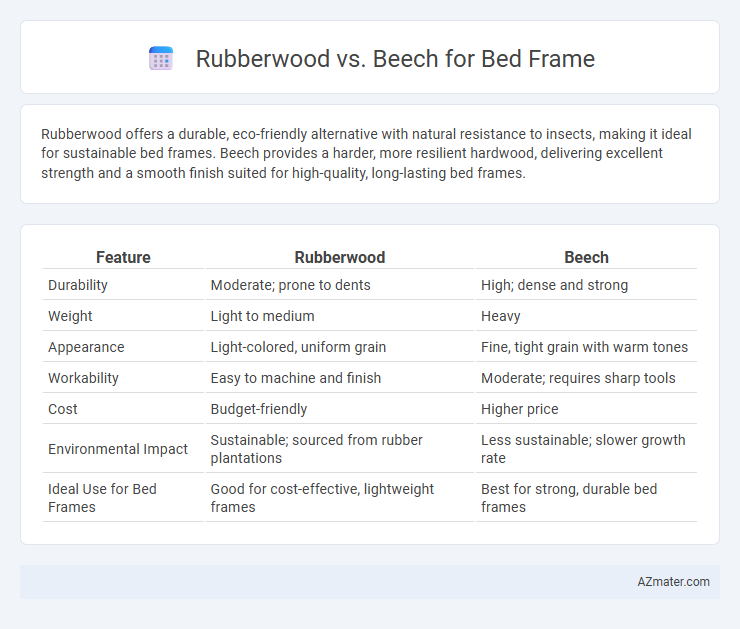Rubberwood offers a durable, eco-friendly alternative with natural resistance to insects, making it ideal for sustainable bed frames. Beech provides a harder, more resilient hardwood, delivering excellent strength and a smooth finish suited for high-quality, long-lasting bed frames.
Table of Comparison
| Feature | Rubberwood | Beech |
|---|---|---|
| Durability | Moderate; prone to dents | High; dense and strong |
| Weight | Light to medium | Heavy |
| Appearance | Light-colored, uniform grain | Fine, tight grain with warm tones |
| Workability | Easy to machine and finish | Moderate; requires sharp tools |
| Cost | Budget-friendly | Higher price |
| Environmental Impact | Sustainable; sourced from rubber plantations | Less sustainable; slower growth rate |
| Ideal Use for Bed Frames | Good for cost-effective, lightweight frames | Best for strong, durable bed frames |
Introduction: Rubberwood vs Beech for Bed Frames
Rubberwood and beech are popular hardwood choices for bed frames, each offering unique attributes in durability and aesthetic appeal. Rubberwood is eco-friendly, sourced from rubber trees after latex harvesting, providing a sturdy yet affordable option. Beech, known for its hardness and smooth grain, delivers a sleek, long-lasting structure ideal for premium bedroom furniture.
Overview of Rubberwood and Beech
Rubberwood is a sustainable hardwood harvested from rubber trees after latex extraction, known for its durability, light color, and resistance to warping, making it ideal for bed frames. Beech wood, a dense hardwood with a fine grain and pale cream color, offers superior strength and smooth finish, popular in high-quality furniture production. Both woods provide stability and aesthetic appeal, but Rubberwood emphasizes eco-friendliness while Beech highlights premium durability and polish.
Durability and Strength Comparison
Rubberwood offers moderate durability and is resistant to warping due to its dense grain, making it a cost-effective choice for bed frames. Beechwood demonstrates superior strength and hardness, providing exceptional stability and long-lasting support suitable for heavy-weight loading. Choosing beech ensures higher durability and resistance to dents, while rubberwood balances affordability with decent structural integrity.
Appearance and Grain Patterns
Rubberwood features a light, pale yellow to creamy hue with a subtle, straight grain pattern that creates a clean, modern aesthetic ideal for minimalist or Scandinavian-style bed frames. Beech wood displays a warm, reddish-brown color with a tighter, more pronounced grain featuring distinctive flecks and small knots, adding rich texture and character to traditional or rustic bedroom designs. Both woods offer smooth finishes, but Beech stands out with its complex grain pattern that enhances visual interest and depth in bed frame construction.
Sustainability and Environmental Impact
Rubberwood, derived from harvested rubber trees after latex production ends, offers a sustainable choice with its fast growth and effective re-use of plantation resources, resulting in lower deforestation and carbon footprint compared to traditional hardwoods. Beech wood, while durable and popular for furniture, often involves slower growth rates and more intensive forestry practices, which can increase environmental impact through habitat disruption and higher carbon emissions. Choosing rubberwood bed frames supports eco-friendly forestry management and reduces waste, making it a more environmentally responsible option.
Cost and Affordability
Rubberwood offers a more budget-friendly option for bed frames compared to beech, with prices typically 20-30% lower due to its widespread availability and faster growth cycle. Beech, known for its durability and fine grain, commands a higher price point, making it a premium choice for long-lasting furniture investments. Choosing rubberwood can significantly reduce upfront costs while still providing reasonable strength and aesthetic appeal for bed frames.
Maintenance and Longevity
Rubberwood bed frames require minimal maintenance due to their natural resistance to moisture and pests, making them ideal for humid environments. Beech wood, known for its dense grain, demands regular polishing to preserve its durability and prevent surface wear over time. Both materials offer excellent longevity, but beech's hardness contributes to greater resistance against dents and scratches compared to rubberwood.
Weight and Handling Differences
Rubberwood bed frames typically weigh less than beech due to the wood's lower density, making them easier to handle and reposition during assembly or room rearrangements. Beech, known for its hardness and durability, has a higher density which results in a heavier frame that offers increased stability but requires more effort to move. The weight difference impacts installation time and portability, with rubberwood preferred for lightweight needs and beech favored for long-lasting, robust bed frames.
Suitability for Bed Frame Construction
Rubberwood offers excellent durability and resistance to warping, making it highly suitable for bed frame construction, especially in humid environments. Beech wood boasts a fine, tight grain and impressive strength, providing sturdy support and a smooth finish ideal for structural bed components. Both woods are sustainable choices, but rubberwood's resistance to moisture often gives it an edge in longevity for bedroom furniture.
Final Verdict: Which Wood is Better for Bed Frames?
Rubberwood offers durability and eco-friendliness, making it an affordable yet sturdy choice for bed frames, while beech wood provides superior strength and a fine grain that enhances aesthetic appeal and longevity. Beech's hardness and resistance to wear make it ideal for heavier bed frames that require long-term stability, contrasting with rubberwood's moderate strength suited for budget-conscious consumers. For those seeking a balance of durability, appearance, and sustainability, beech is typically the better option for high-quality bed frames.

Infographic: Rubberwood vs Beech for Bed Frame
 azmater.com
azmater.com